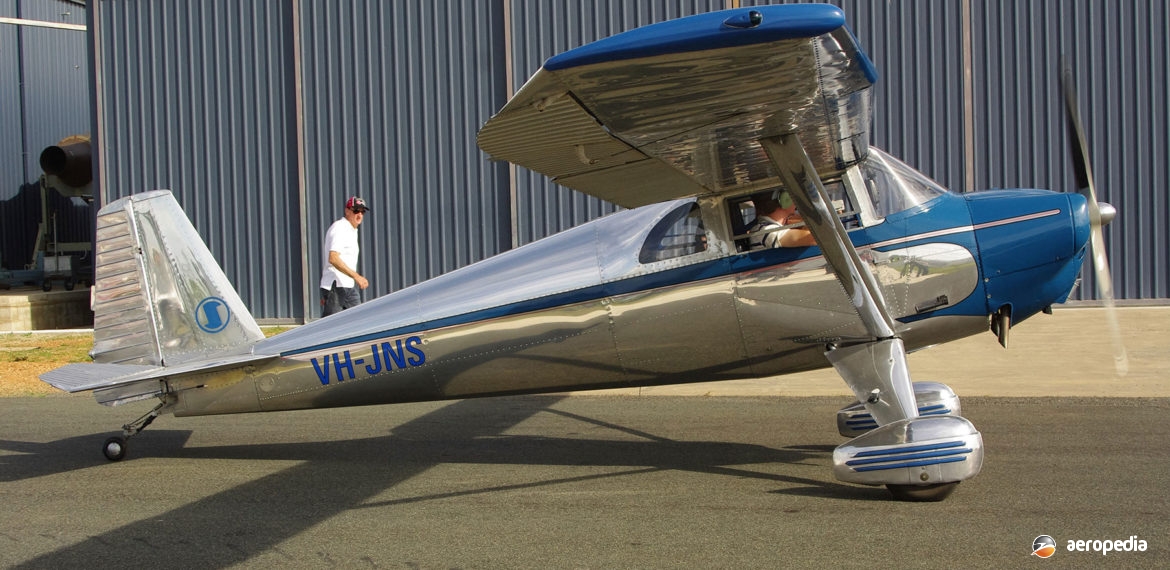Photograph:
Luscombe 8 Silvaire VH-JNS (c/n 6399) at Temora, NSW in April 2012 (David C Eyre)
Country of origin:
United States of America
Description:
Light touring monoplane
Power Plant:
One 48 kw (65 hp) Continental A65 four-cylinder horizontally-opposed air-cooled engine
Specifications:
- Wingspan: 10.7 m (35 ft)
- Length: 6 m (20 ft)
- Height: 1.8 m (5 ft 10 in)
- Wing area: 13 m² (140 sq ft)
- Max speed: 185 km/h (115 mph)
- Cruising speed at 75% power: 164 km/h (102 mph)
- Stalling speed: 61 km/h (38 mph)
- Initial rate of climb at sea level: 198 m/min (650 ft/min)
- Service ceiling: 4,572 m (15,000 ft)
- Range: 595 km (370 miles)
- Fuel capacity: 57 litres (12.4 Imp gals)
- Empty weight: 302 kg (665 lb)
- Useful load: 243 kg (535 lbs)
- Loaded weight: 544 kg (1,200 lb)
History:
The Luscombe series of light monoplanes was introduced by the Luscombe Airplane Corp in 1937. Powered by a 37 kw (50 hp) Continental engine, the Model 8, also known as the Luscombe 50, received type approval in August 1938. Production rate was quickly increased to meet demand, with most aircraft being delivered to flying schools throughout the USA. In 1939, with the introduction of the new 48 kw (65hp) Continental engine, a new model, the 8-A, was released, with a further variant, the 8-A2, being introduced later with extra equipment and a deluxe interior. The 8-B was a training variant. By 1941 the 56 kw (75 hp) Continental engine had been fitted, and the aircraft was known as the Model 8-C in its standard form or the 8-D in the deluxe version. However, after some 1,200 examples had been built, production ceased in 1942 when the company was requested to divert its production capacity to military contracts.
After the war Leopold Klotz, who had taken over the Company from Don Luscombe, had a new plant built near Dallas, Texas, and designed a new all-metal wing with a single strut for the Model 8 series. All Silvaires were then constructed with this new wing, the 1946 model becoming the 8-E with a 63-kw (85-hp) engine, and the 1948 model with a 67 kw (90 hp) engine becoming the 8-F. However, in 1949 financial difficulties forced the Luscombe Co, as it was then known, to close down.
The monocoque fuselage was of all-metal construction built up of 17ST dural oval bulkheads covered with metal sheet. The wing struts and undercarriage were attached to dural forgings, and the engine mount was of welded steel tube, the engine being mounted in rubber bushings. The wing framework was built up of extruded dural I-beams with the leading edges covered with metal sheet, the completed framework being covered with fabric. Later models from the 8-D onward had a 45 litre (10 Imp gals) fuel tank in each wing root.
Temco Engineering then took over production, but only a few Silvaires were built and the new line closed again in 1950. In 1955 a group in Colorado recommenced production and built a number of aircraft until 1960 when the line was closed yet again. One Model 8-A Silvaire was imported to Australia in 1981 and, after restoration work, became VH-LUS (c/n 2845). Further examples have been imported and more than 15 have been registered in this region. Three are known to be in New Zealand, two airworthy (N1737K – c/n 4484 and N45856 – c/n 2883), and a further machine is awaiting restoration at Pokeno.
Over the years there have been numerous reports of the Silvaire being put back into production and eventually in 2006 Renaissance Aircraft at Flabob Airport, California, announced it had placed the Luscombe 8 back into production under new Light Sport Aircraft (LSA) regulations, offering a tailwheel model and a tricycle undercarriage variant, powered by the Continental O-200 engine, but also available with the Lycoming O-320 series.

